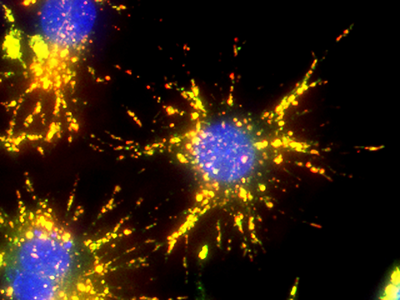The cell nucleus is a membrane-bound organelle that contains a majority of the cell’s genetic material (DNA) in the form of chromosomes. The main components of the nucleus include the nuclear envelope, a double membrane that encloses the entire organelle and isolates its contents from the cytoplasm, and the nuclear matrix, a network within the nucleus that adds mechanical support. Its primary functions include controlling gene expression, regulating DNA replication, and preserving the integrity of the DNA it houses.
Visualization of the cell nucleus either by fluorescence microscopy or flow cytometry is frequently done using high affinity nucleic acid dyes. Before binding to DNA or RNA, the intrinsic fluorescence of these dyes are minimal and once bound its fluorescence intensity enhances significantly. Nucleic acid dyes are available in membrane permeant and impermeant formats for live and dead cell analysis, and in a variety of wavelengths to support multiplex and colocalization studies with other fluorescent probes.
Membrane Permeant Nucleic Acid Dyes
Membrane permeant nucleic acid dyes can be used to label both live cells with healthy intact cell membranes, as well as cells with compromised membranes such as dead, fixed or permeabilized cells. The overall toxicity of these dyes are relatively low with minimal effect on cell functionality, allowing for live cells to be tracked during stages of development and cellular processes such as mitosis and miosis, or as a suitable counterstain in live cells. Examples of cell-permeant nucleic acid dyes include Hoechst dyes and AAT Bioquest’s Nuclear Violet™ LCS1, Nuclear Green™ LCS1, Nuclear Orange™ LCS1 and Nuclear Red™ LCS1/LCS2 dyes.
Membrane Impermeant Nucleic Acid Dyes
Membrane impermeant nucleic acid dyes can be used to label the nuclei of cells with compromised plasma membranes, these include dead, fixed or permeabilized cells. Since cell-impermeant nucleic acid dyes cannot label live cells, they are frequently used in cell viability studies as a dead cell indicator or as a nuclear counterstain in colocalization or immunolabeling applications. Examples of cell-impermeant nucleic acid dyes include DAPI, propidium iodide (PI), 7-aminoactinomycin D (7-AAD), Nuclear Blue™ DCS1, Nuclear Green™ DCS1, Nuclear Orange™ DCS1, and Nuclear Red™ DCS1. Cyanine dimer dyes – DiTO™, DiYO™ and TWO-PRO™ – also display exceptional sensitivity for nucleic acids including double-stranded DNA (dsDNA), single-stranded DNA (ssDNA) and RNA. These symmetric dimmers of cyanine dyes exhibit a 100 to 1000-fold fluorescence enhancement upon nucleic acid binding and their molar extinction coefficients are an order magnitude greater than ethidium homodimers.







